Moving in with a partner usually means you’re merging two totally different design styles. Maybe you’re into modern furniture but your partner loves classic, traditional pieces.
Remember to repin your favorite images!
That clash can feel stressful when you’re decorating a shared home.
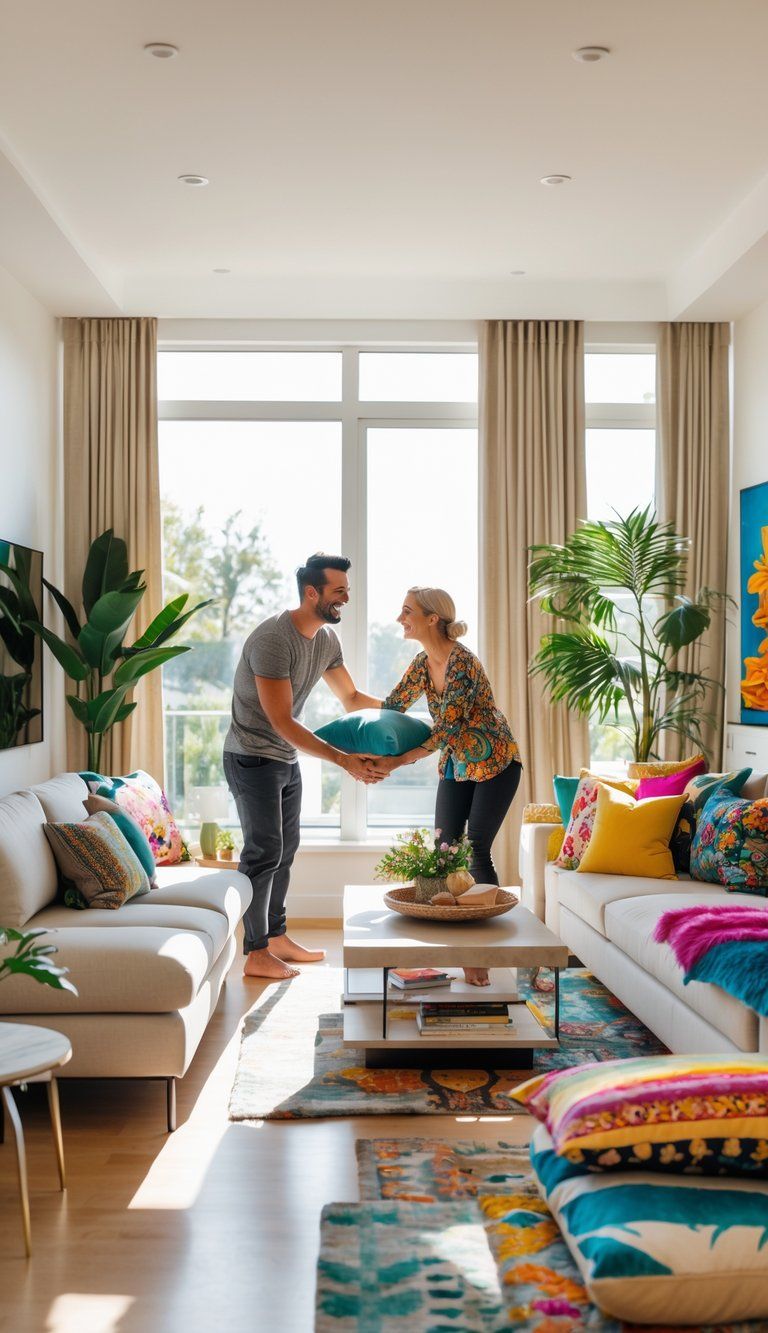
Here’s the upside: mixing different interior design styles can actually make your place more interesting and personal. Instead of seeing your differences as a headache, try thinking of them as a chance to create a home that really tells your story together.
When you combine both your styles, your home feels more authentic—lived-in, even—than if you just stuck to one approach.
The trick is finding some balance and pulling it all together with shared elements, like color or materials. With a bit of compromise (and some creativity), you can make a space where you both feel at home.
Understanding Your Personal and Shared Styles
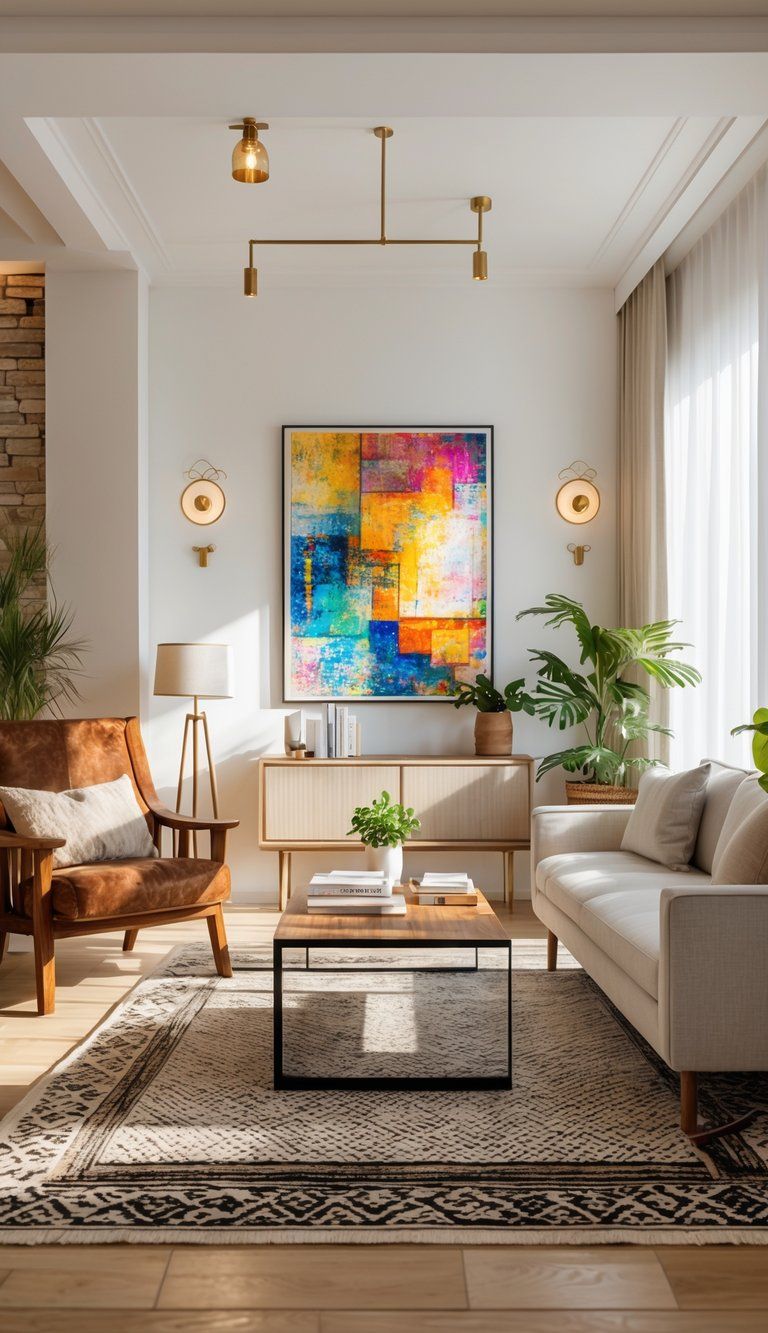
Before you start creating a home that works for both of you, take some time to figure out what each of you actually cares about in design. Exploring your preferences lays the groundwork for compromise.
Identifying Individual Design Preferences
Kick things off by having each person make a design profile. Write down what you love and what you just can’t stand.
Think about:
- Colors: Are you into bold shades or do you gravitate toward neutrals?
- Materials: Wood, metal, glass, soft textiles—what catches your eye?
- Furniture styles: Modern, traditional, industrial, eclectic—pick your favorites.
- Must-have elements: What could you not live without?
Flip through design magazines or scroll Pinterest together and save images that really speak to you. Sometimes you don’t even realize you like something until you see it.
“People often can’t articulate what they like until they see it,” says designer Jewel Marlowe. Having examples makes the conversation way more productive than just talking in vague terms.
Recognizing Overlapping Style Elements
Look for spots where your tastes overlap. Most couples find more common ground than they expect.
Draw a Venn diagram with three sections:
- Your likes
- Your partner’s likes
- Shared likes (smack in the middle)
Start with the middle section when making decisions. For instance, if you both like wood but can’t agree on the finish, maybe you can mix wood tones that play nicely together.
Notice how you feel about different spaces. Sometimes styles that seem worlds apart actually share qualities like comfort or brightness.
Appreciating Differences in Aesthetic Values
You’ll often find that style preferences run deeper than just looks. Maybe one of you values coziness, while the other loves clean lines and open space.
Ask each other why you like certain styles:
- Does it remind you of something?
- Is it about how you want to feel at home?
- Are there practical reasons behind your favorites?
These chats help you see that design choices usually have meaning. Sometimes your partner’s attachment to a style comes from childhood or culture.
Stay open. You might end up loving something you never would’ve picked on your own.
Effective Communication About Design Choices
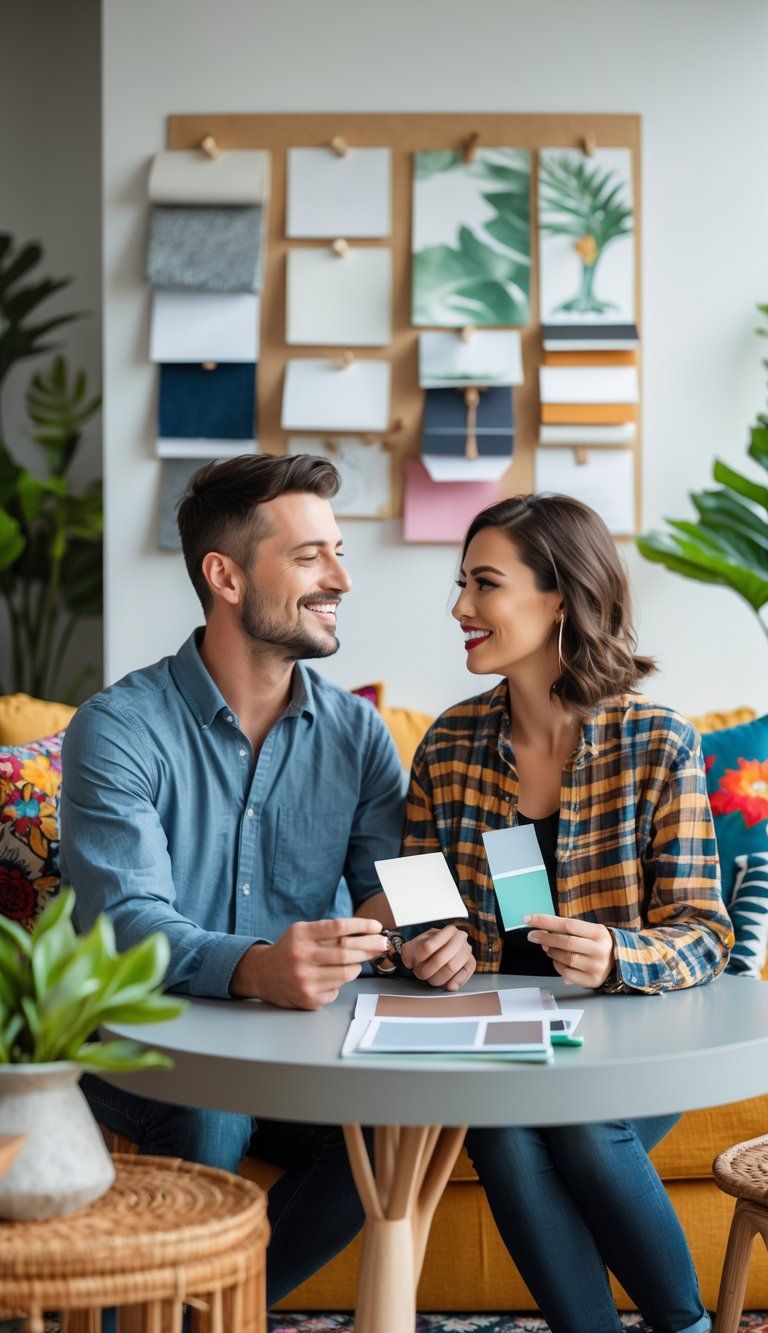
You’ll need honest, open conversations about design if you want to create a home together. Good communication keeps misunderstandings at bay and makes compromise a lot easier.
Expressing Your Vision Respectfully
Before you even start talking, get clear on your own priorities. Jot down your must-haves versus your nice-to-haves so you know what really matters.
When you share your ideas, stick to “I” statements. For example, say, “I prefer warmer colors because they make me feel cozy,” instead of, “Your color choices are too cold.”
Visuals help a ton. Make a shared Pinterest board or folder for inspiration. That way, you both know what you mean by “modern” or “cozy” or whatever buzzword comes up.
Point out exactly what you like about a design. Instead of “I like this room,” try, “I love how the natural light flows through these curtains.”
Active Listening to Your Partner’s Ideas
Give your partner your full attention. Seriously, put the phone down during these talks.
Ask open-ended questions to really get what they’re saying:
- “What feeling do you want this room to have?”
- “Which details matter most to you?”
- “Are there memories or experiences behind your style choices?”
Even if you disagree, let them know you hear them. A simple “I can see why you’d like that” goes a long way.
Try to get at the needs behind their preferences. Sometimes what looks like a style clash is really about comfort or practicality.
Navigating Design Disagreements Productively
When you hit a wall, step back and look at your shared goals. Remember, you both want a home you’ll love.
Try trading off. If your partner picks the couch style, maybe you get to choose the color. This way, both of you have a say.
Sometimes, bringing in a neutral third party—like a designer—can help you find solutions you hadn’t considered.
Test out changes in a small area before you go all in. That way, you can live with a new look before making it permanent.
You don’t have to agree on everything to have a beautiful home. Some of the most interesting spaces have a bit of contrast and personality.
Finding Common Ground and Shared Priorities
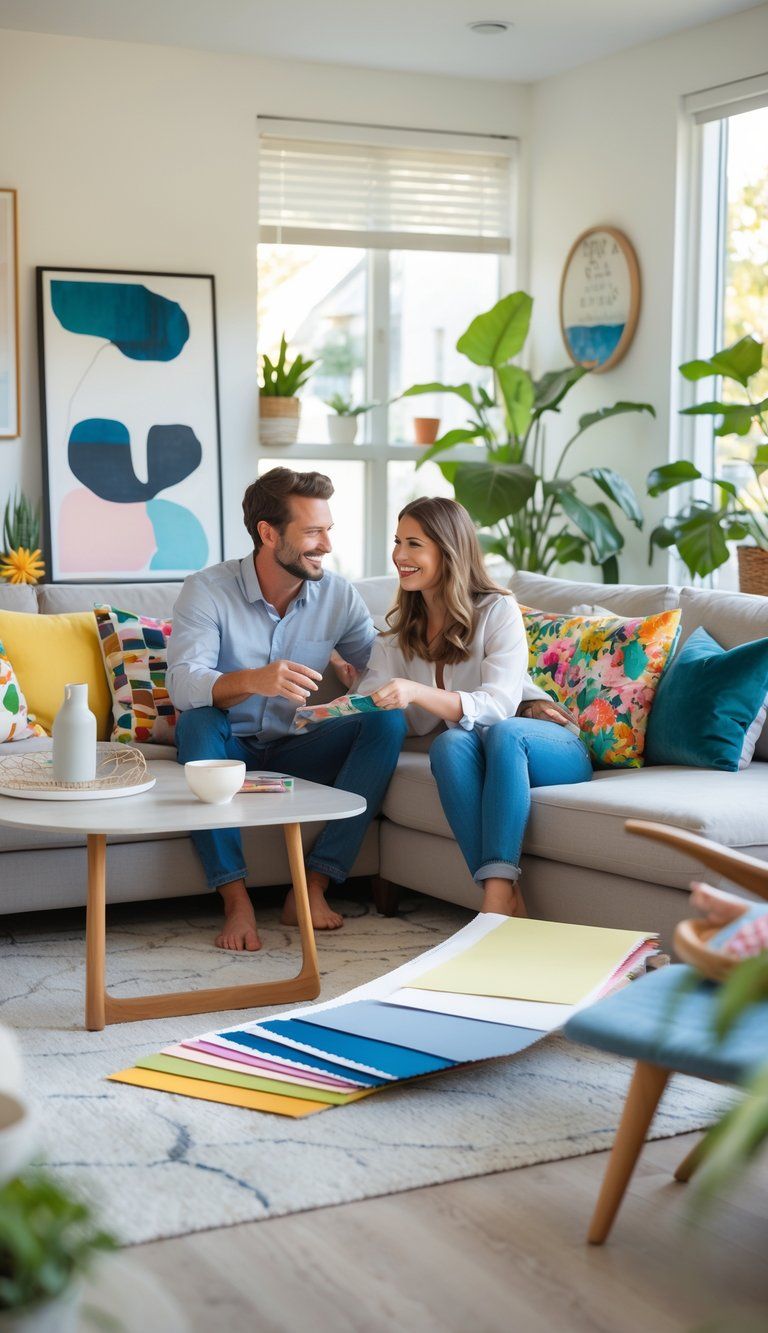
Building a home you both love starts with honest talks about what’s most important. When you figure out where your needs and wants overlap, you can make design choices that work for both of you.
Identifying Must-Haves for Each Partner
Start by making your own list of non-negotiable items or features. Maybe it’s a favorite chair, a family heirloom, or a color palette you can’t give up.
Explain why these things matter to you. Sharing the emotional connection helps your partner understand where you’re coming from.
Try a quick rating system:
- Must-have: Can’t live without it
- Would like: Prefer it, but it’s not a dealbreaker
- Can live without: Meh, not essential
Design quizzes can reveal surprises—sometimes you have more in common than you think. You might both love certain textures or lighting, even if your styles look different on the surface.
Agreeing on Functional Needs
Think about how you actually use your space, not just how it looks. Practical needs often give you natural common ground.
Ask yourselves:
- Which rooms do you use the most?
- What do you do in each space?
- What storage solutions do you both need?
- How do you like to host friends or family?
Make mood boards together to see what works visually. Pin images that show both styles and look for connections—sometimes you’ll spot something unexpected that ties it all together.
Let function lead the way. If a room looks great but doesn’t work for your daily life, it’ll just end up being annoying.
Blending Distinct Styles Into a Cohesive Whole

You don’t need to compromise away your style—instead, think about how you can thoughtfully blend your tastes. The trick is to find common threads that connect your styles, letting both of you shine.
Choosing a Unifying Color Palette
A solid color scheme can instantly tie together different styles. Pick 3-5 colors you both love and use them throughout your home.
“An easy way to keep an eclectic style cohesive is to stick to a methodical and intentional color palette,” says designer Jewel Marlowe. “If the color scheme is tailored, then it is easier to pull off the surprise of mixing two or more unexpected styles together.”
Try this:
- Make one neutral color the base (about 60% of the space)
- Add 2-3 accent colors (about 30%)
- Use one bold color for a pop (about 10%)
This approach lets modern pieces mix with vintage ones, as long as the colors connect.
Incorporating Transitional Pieces
Transitional pieces bridge the gap between styles. These items borrow something from each look, linking them visually.
Say you love modern minimalism but your partner’s into traditional. Look for:
- A sofa with clean lines and classic tufting
- Modern tables in warm wood
- Lighting that updates a traditional shape
Skip the matching furniture sets—they can make a room feel flat. Instead, mix up shapes and textures that play well together.
You’re not aiming for perfect matches, but for thoughtful combinations that tell your story.
Balancing Contrasting Design Elements
Balance keeps your space intentional, not chaotic. Think of it as a conversation between different pieces.
When you mix styles, try these ideas:
- Balance scale: Pair a big, traditional piece with something equally bold from your partner’s style
- Spread styles out instead of creating “his and hers” corners
- Find texture overlaps to tie it all together
Use accessories—pillows, throws, art—to add both styles without a big commitment. A modern sofa can work with boho pillows and a rustic blanket.
Contrast, when you manage it well, gives your space depth and interest that matching sets just can’t.
Room-by-Room Strategies for Harmony
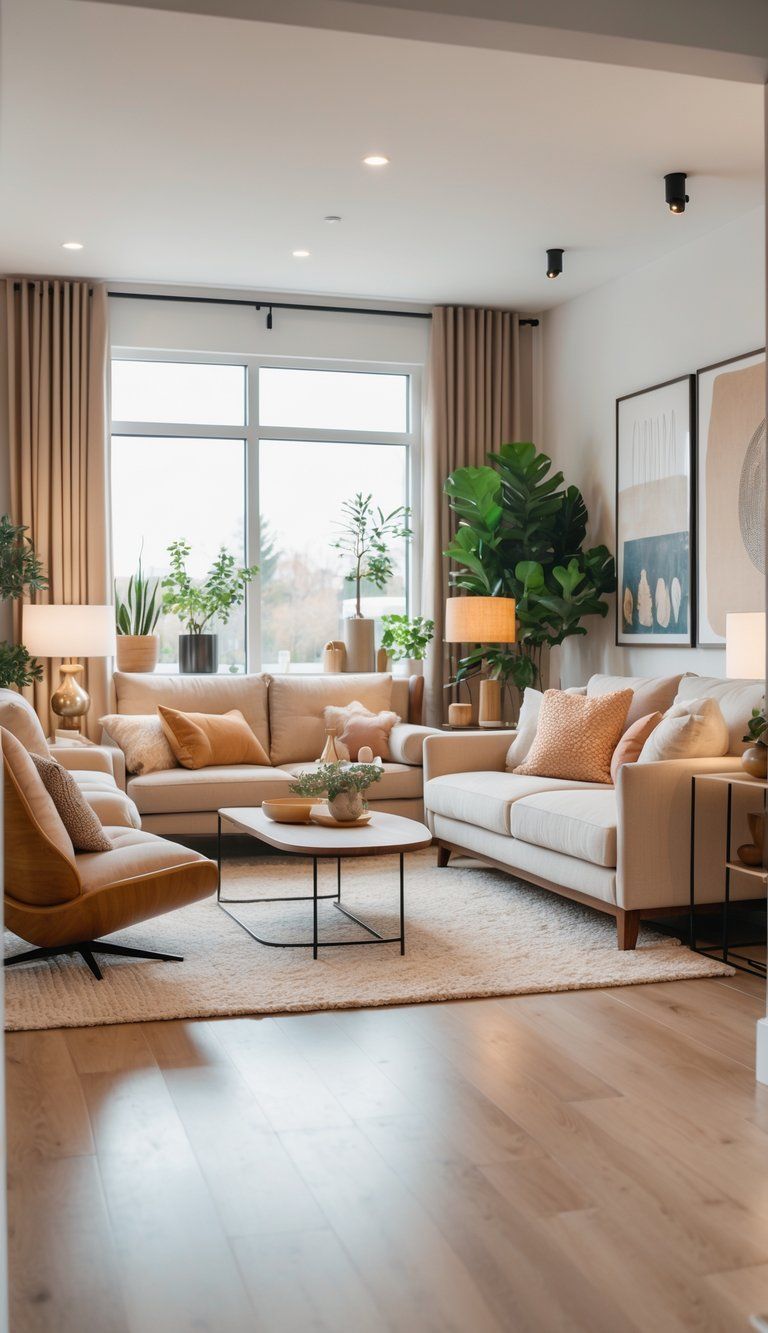
Each room offers a new chance to blend your styles. With a little planning, you can create spaces that feel unified but still let both personalities come through.
Merging Styles in Shared Living Spaces
Living rooms and dining areas are prime spots for style blending since you both use them. Start by finding what you agree on—maybe you both love comfort or care about lighting.
Pick a neutral base for big pieces like walls and floors. This gives you a blank slate for layering in both of your styles. Then, alternate choices: if your partner picks the sofa, maybe you choose the coffee table.
Easy ways to compromise:
- Share a color palette, but mix up textures and patterns
- Go for furniture with clean lines that work with lots of looks
- Create “style zones” to spotlight each aesthetic
- Bring in meaningful pieces from both sides
Accessories are your friend here. Swap out pillows, art, or table décor with the seasons to let each style have its turn.
Creating Personal Retreats Within the Home
Home offices, hobby rooms, and reading nooks are perfect for showing off individual style. These personal spaces let each of you go all-in on your aesthetic.
Tips for solo spaces:
- Set clear boundaries for who gets design say in which rooms
- Keep doorways and transitions in sync with the rest of the house
- Give each other total freedom within your own space
- Think about sound and privacy too
These zones matter for personal happiness. Maybe your craft room bursts with color and clever storage, while your partner’s music nook is all vintage gear and moody lighting.
Respect each other’s domains. Don’t critique your partner’s choices in their retreat, and pay attention to how the space flows into shared areas.
Harmonizing Bedroom Aesthetics
Bedrooms really need extra attention because they have to make both partners happy and still feel relaxing and intimate. Start with an honest talk about sleep needs and what makes each of you comfortable.
Pick bedding made from good materials in colors you both like. Add throws and pillows you can swap out easily when someone wants a change.
Bedroom balancing strategies:
- Go for furniture with clean, classic lines.
- Choose a wall color that fits both of your color preferences.
- Let each person decorate their own nightstand.
- Agree on window treatments that solve practical problems first.
Lighting changes the whole vibe. Try mixing ambient lights you love with the reading lamps your partner prefers.
Remember, compromise feels a lot better when you both get something you actually want.
Establishing Design Boundaries and Compromises
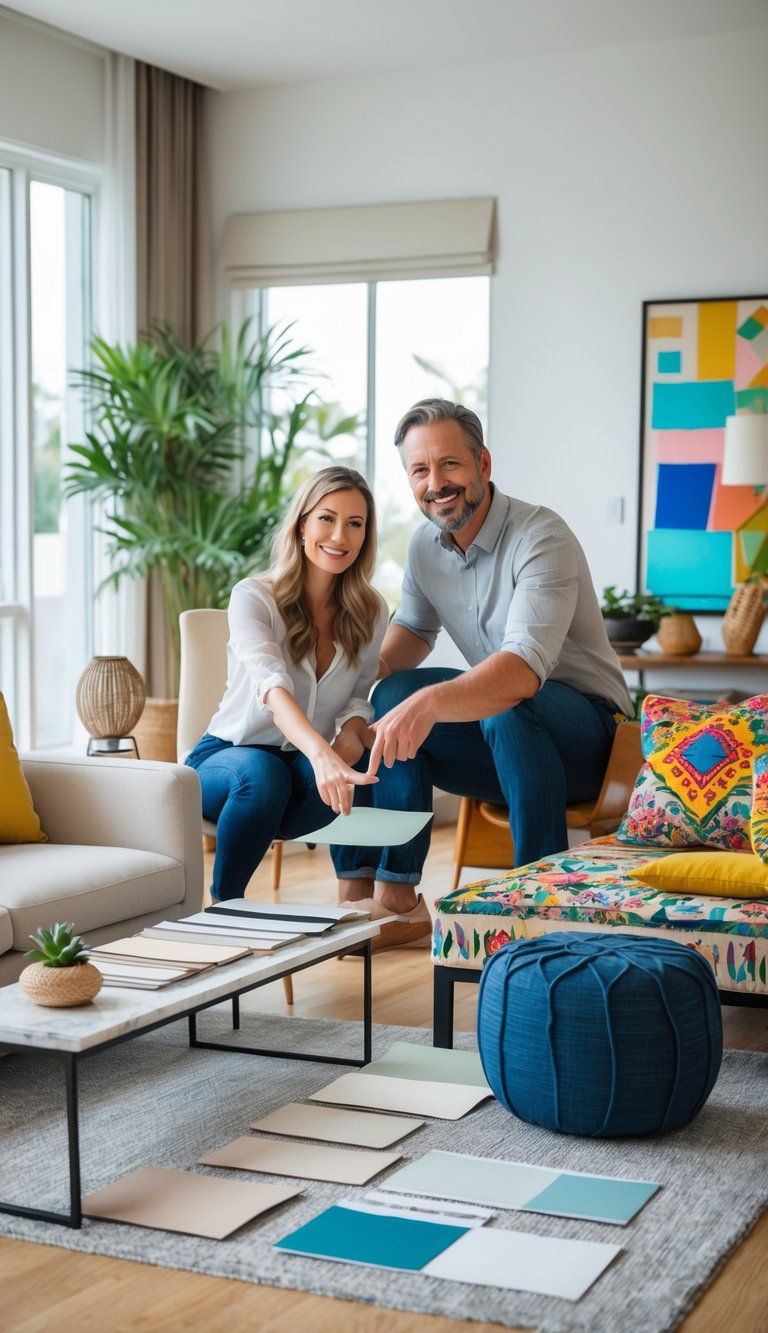
When your styles clash, you need clear boundaries and smart compromises. Set up personal spaces and some ground rules so your home respects both of your tastes.
Defining Spaces for Individual Expression
Give each person a spot to show off their design preferences. This keeps things balanced and avoids style battles everywhere.
Try these for personal zones:
- Home offices let you go all-in on your own style.
- Hobby rooms can showcase individual interests without taking over shared spaces.
- Reading nooks or private bathrooms are great for a little self-expression.
Talk openly about boundaries when you set up these areas. Maybe you agree that furniture in your personal space won’t clash with the next room over. That way, transitions between spaces don’t feel jarring.
Designer Steven Graffam admits even experts struggle with this: “Living with another designer means constant creative compromise!” Respecting each other’s zones really helps.
Deciding When to Prioritize One Partner’s Choice
Sometimes, you just have to let one partner’s preference win. Set up a fair way to handle these moments so nobody feels left out.
Try these ideas:
- Take turns making decisions for different rooms or projects.
- Think about emotional value—if something really matters to one of you, let it carry more weight.
- Lean on expertise—if one of you knows more about a certain area, let them lead.
Lemondrop Home experts say, “Compromise is essential, but it shouldn’t mean sacrificing what you truly love.” Take turns steering design choices in different spaces.
When you hit a tough spot, focus on your shared vision. Ask each other which choice actually fits the life you want together. Keeping your home’s purpose in mind makes decisions a bit easier.
Incorporating Sentimental and Personal Items
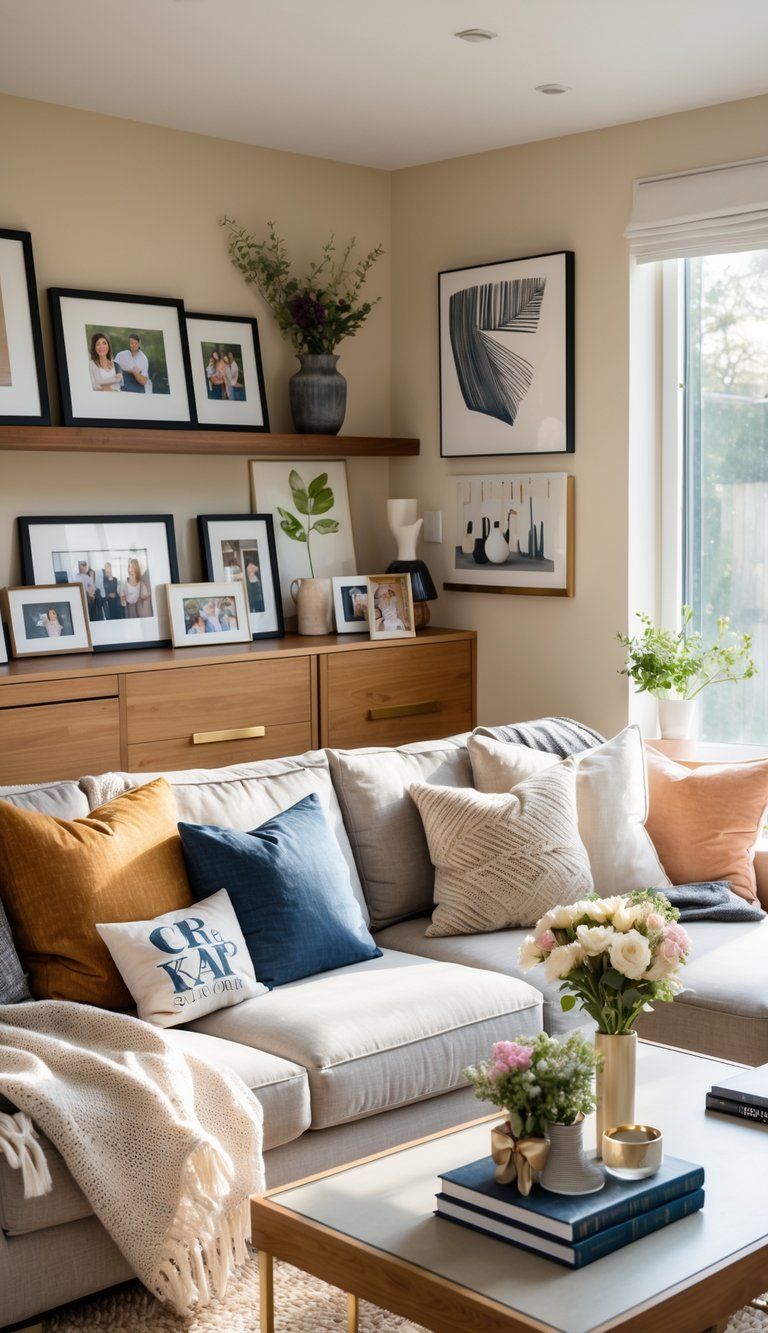
Every home tells a story, and personal items are at the heart of it. When you mix styles, these pieces can spark the most debate.
Pick a few meaningful items from each of your collections instead of displaying everything. Less is more—too much creates clutter.
Designate spaces for personal items. Maybe you set up:
- A gallery wall with both of your art or photos.
- A special shelf for collectibles.
- A memory corner in the bedroom.
Try switching out displays seasonally. That way, your home stays fresh and you both feel seen.
Update sentimental items if you can. That old sports pennant might look better framed. Your partner’s childhood toy collection could become a cool display in a glass case.
Use compromise zones and personal zones. Shared spaces can show off agreed-upon pieces, while offices or hobby rooms let you go wild with your own style.
Bringing in meaningful pieces isn’t just about looks—it’s about honoring what matters most. The lamp from your partner’s grandmother might not be your favorite, but its story adds something special.
Ask each other why you love certain items. When you understand the meaning, it’s easier to find middle ground.
Leveraging Professional Guidance
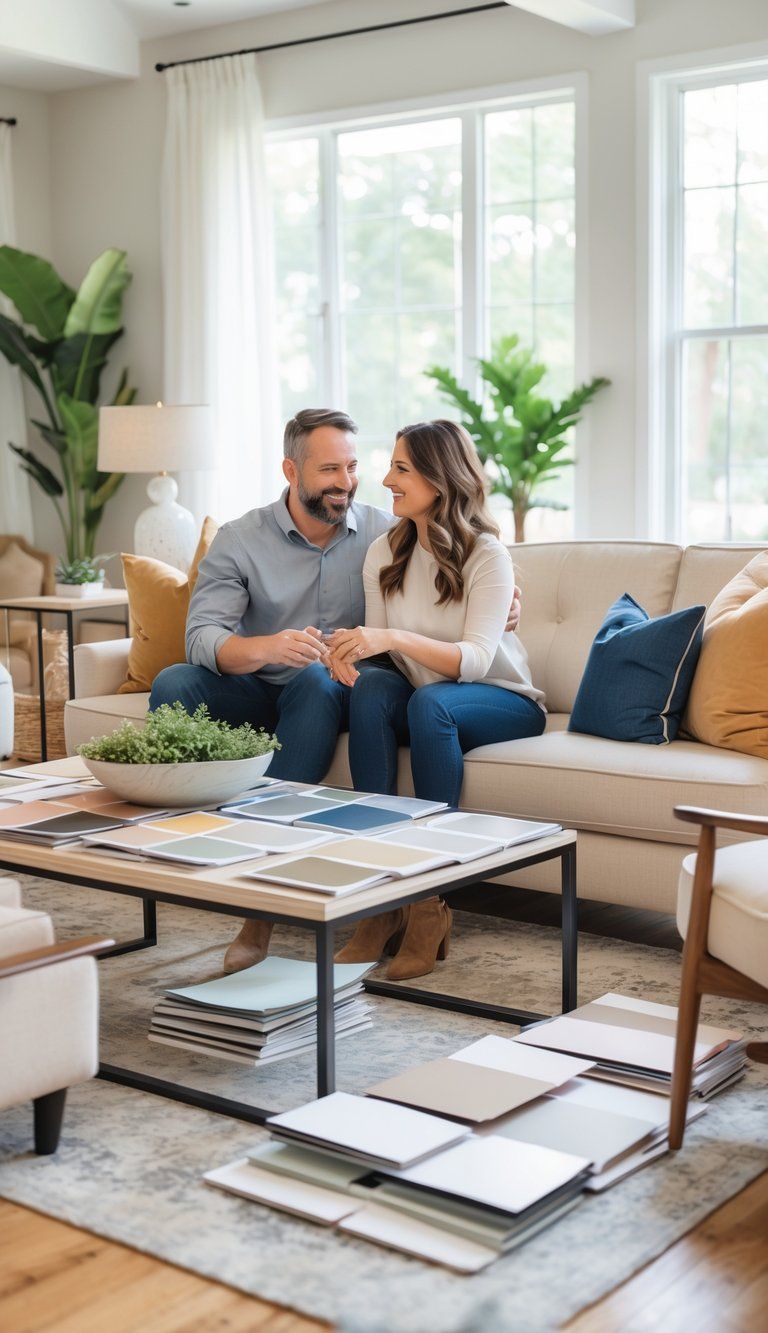
Blending design styles sometimes calls for outside help. Professionals can save you time, money, and headaches when you want a space that works for both people.
Consulting with Interior Designers
Interior designers know how to mix different styles into something that feels right. If you and your partner can’t agree, a designer can step in as a neutral voice and suggest solutions.
Designers usually start with a meeting to ask about:
- What each of you wants and needs
- Items you both care about
- Your budget and timeline
- How you use each room
They’ll put together a plan that pulls from both your styles. Maybe they recommend a neutral foundation with accents that reflect each of you. Costs range from $100-$500 for a consult to several thousand for a full plan.
A lot of designers offer virtual services now, which can be more affordable.
Utilizing Online Design Tools
If hiring a designer isn’t doable, try online tools to blend your styles for less.
Free apps like RoomSketcher or Planner 5D let you:
- Build digital versions of your rooms
- Move virtual furniture around
- Test out color schemes
- Share ideas with your partner
Many stores have visualization tools on their sites. Upload a photo of your room and drop in their products to see how they look.
Pinterest boards work too. Make a shared board and pin things you both like. Over time, you’ll probably spot some overlap in your tastes—a great place to start.
Creating a Home that Evolves with Your Relationship
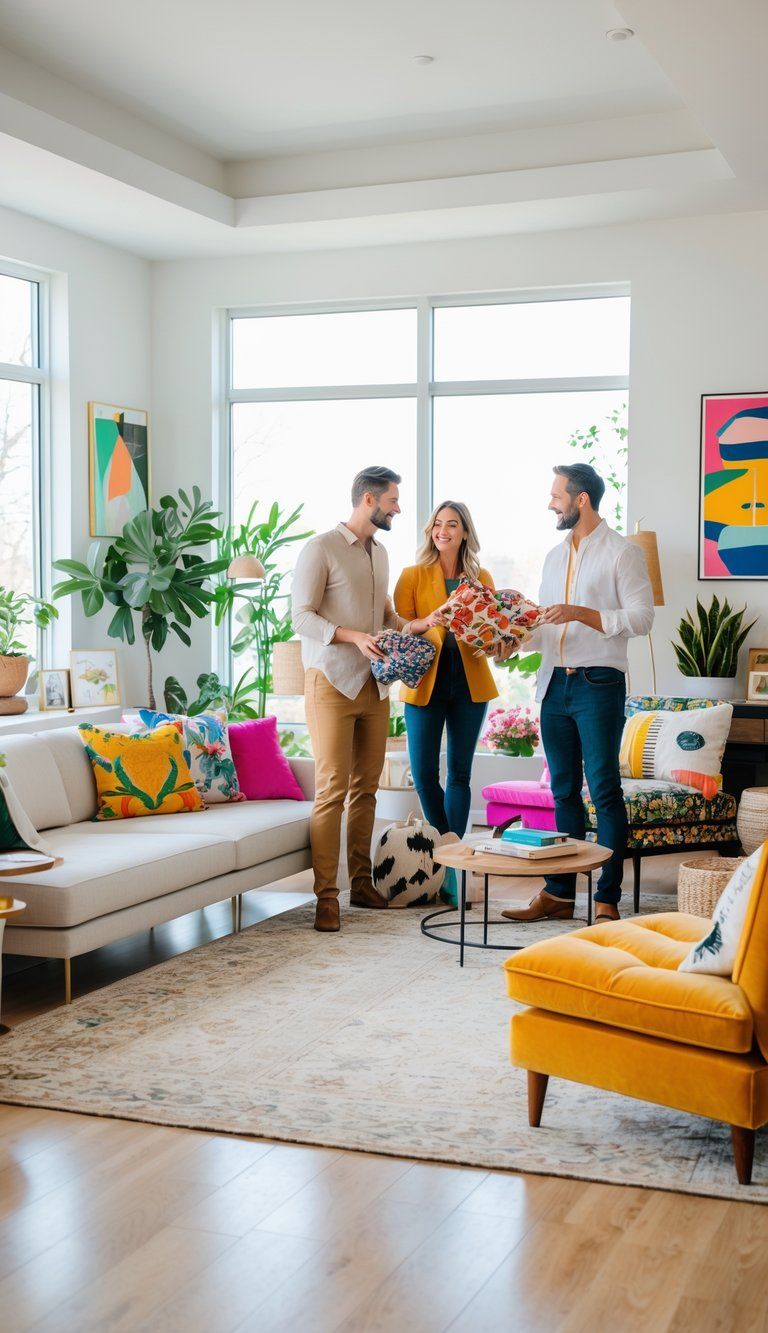
Your home should grow with your relationship. As you both change, your space needs to shift with your new preferences and life stages.
Adapting Your Home Over Time
Homes need to keep up as relationships shift. What worked when you first moved in might not fit five years later.
Start with flexible furniture that can move from room to room.
Set up zones that can change as life changes. A home office might become a nursery, then a playroom, and later a teen hangout. Modular sofas and extendable tables make life easier.
Keep talking about what you like and don’t like as time goes on. Maybe bold colors grow on your partner, or you want to try something new. Regular “design check-ins” help you figure out what’s working.
Take photos of your space as it changes. Looking back can be a sweet reminder of how far you’ve come together.
Celebrating Compromise as a Strength
The best homes show off thoughtful compromise, not just one person’s taste. Every design decision you make together helps you get better at working as a team.
Try listing three things each of you needs to feel at home. Make those non-negotiable and build around them.
Look for surprising combos that work—his industrial lamp with your vintage chair might be perfect.
Display items from both your lives. That travel souvenir you picked out together may not match everything, but it tells your story.
Compromise isn’t about settling. It’s about building something new that honors both sides—a home that really feels like yours, together.
Sustaining Cohesion and Satisfaction Long-Term
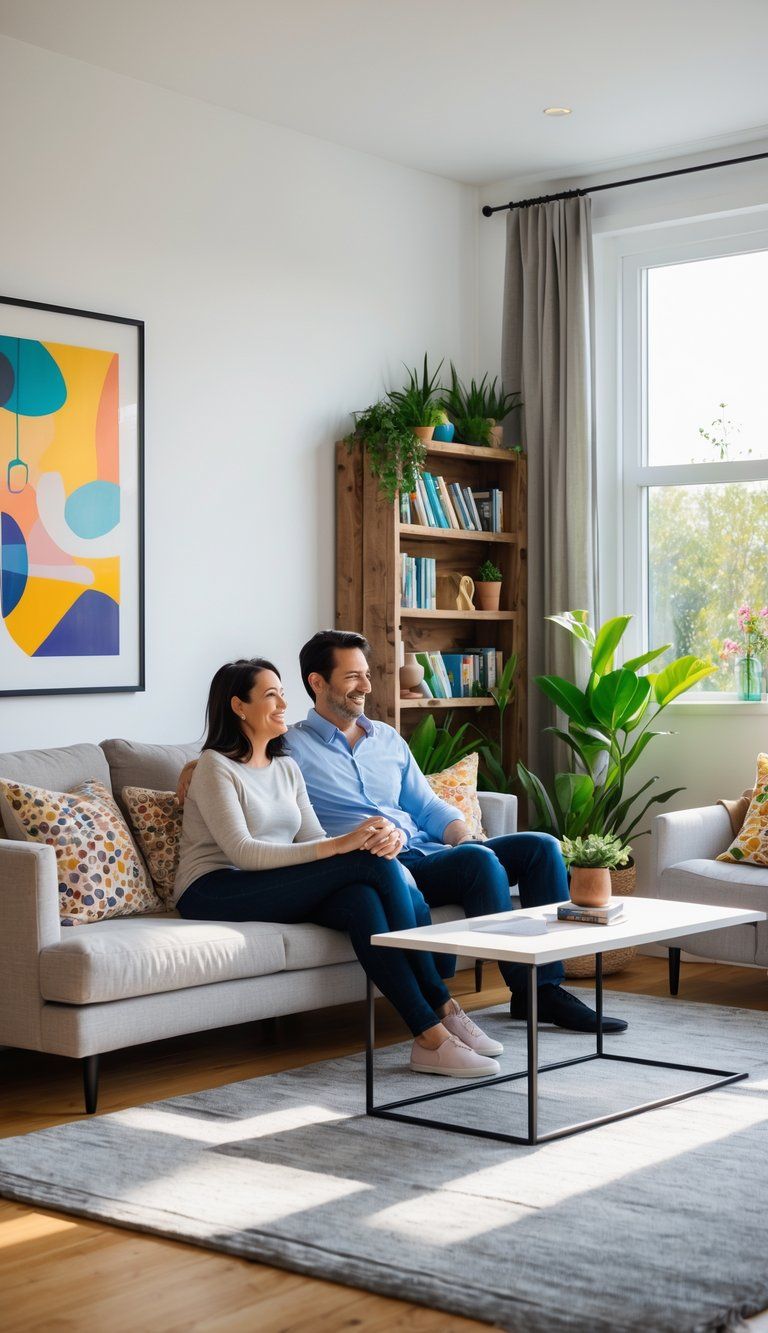
Keeping your home looking good while respecting both partners’ tastes takes ongoing effort. You can catch a lot of frustration early just by checking in about how you both feel about your shared spaces.
Every few months, set aside a little time to talk about what’s working and what feels off. Honestly, these chats work best when they’re casual—maybe over dinner or a lazy cup of coffee on the weekend.
Create a system for new purchases:
- Who gets the final say?
- Is there a budget cap for solo choices?
- Which rooms need joint approval?
Your home will change as you do. What feels right now might not fit in a few years, and that’s totally fine.
Try swapping out seasonal decor to keep things fresh and balance both your styles. Maybe your partner’s bold colors shine in summer, and your love of neutrals sets the mood in winter.
Make a shared inspiration board—digital, physical, whatever works. Toss in ideas that catch your eye. You might be surprised by how much overlap you find.
Take turns leading small design projects, too. Letting each person steer a space now and then builds a lot of mutual respect.
The most cohesive homes aren’t always perfectly matched. They’re the ones where you can actually see the compromise and the fact that two real people live there together.

